The candlestick telephone and how it was used
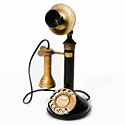
Candlestick phones were the first type of phones to reach ordinary homes, shops, offices and suchlike, although only the more affluent homes made the somewhat up-market decision to go 'on the phone' in the late 1920s or early 1930s. This page describes and illustrates various candlestick phones: the earliest ones with no dial and later ones with dials. The page goes on to show the 1921 Post Office instructions for making and receiving a call - much of which seems strange to us today. Direct dialling was decades away.
____
Extracted from the memoirs of the webmaster's mother (1906-2002) and edited by the webmaster with further research
The appearance of candlestick telephones
Candlestick telephones got their name by being tall and narrow, just like a candle in a candlestick. At the time when these phones came onto the market, candles for lighting were still in daily use in many homes. In later years, candlestick phones were also referred to as upright phones.
The mouthpiece and earpiece
Candlestick phones were in two parts with the mouthpiece fixed at the top, reminiscent of the position of the flame of a candle. The earpiece was separate. It rested on a cradle when the phone was not in use and was lifted to the ear when in use.
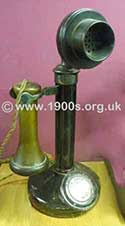
1920s candlestick phone with no dial
The separate bell
These two-piece candlestick phones, like the earliest versions of the more compact two-piece phones of later years, needed a separate bell which was contained in a quite bulky box, normally hidden away against a wall under the table on which the phone stood. It would be more accurate, therefore to refer to them as three-piece, not that anyone did because of the bellbox being normally out of sight.
How different these early phones were from the mobile phones of today, which - quite apart from the advantage of being mobile - have all their necessary working parts contained inside themselves.
How to make a call with a candlestick phone
The earliest candlestick phones such as the one in my husband's family had no dial to get to a number directly, just a disk stating the number of the user's phone and other information on making the call. Lifting the earpiece from its cradle attracted the attention of the operator at the local telephone exchange - at least that was the idea. If she didn't answer - which was not uncommon if she was on another line or chatting, the caller would jiggle the cradle up and down repeatedly.
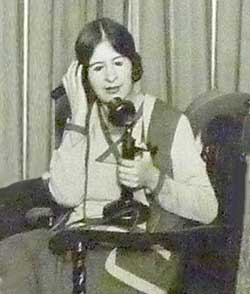
Woman using a candlestick phone. Note that it needed two hands.
Photo courtesy of Milton Keynes Telephone Museum.
Later candlestick phones had a dial in the base as shown below, just with numbers.
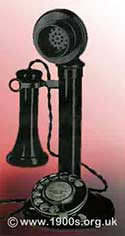
Candlestick phone with a dial, the manual equivalent of today's keypad
Then local calls - only local ones - could be dialled directly using just the number one wanted. It was usually a small number like 3 or 11 as few homes or businesses had phones. Longer distance calls still had to be made through the operator, as described on another page.
By 1934, some candlestick phone dials had letters as well as numbers - the letters indicating the area of the user, but by then most people were going over to the newer phones, all of which had dials of numbers and letters. The letters were known as area codes. The instructions for using these dial phones to make a call is described below for the later models, but the procedure for the earlier models was effectively the same.
Post Office instructions for making and receiving a call
The Post Office thought it necessary to instruct callers on speaking clearly to the operator when using early phones. Instructions were as shown in the following leaflet which is transcribed further down the page. In the transcription, 'subscriber' is what we might call 'caller', and 'telephonist' is what we would call the 'operator'. (Try to ignore the sexist language which was normal at the time.)
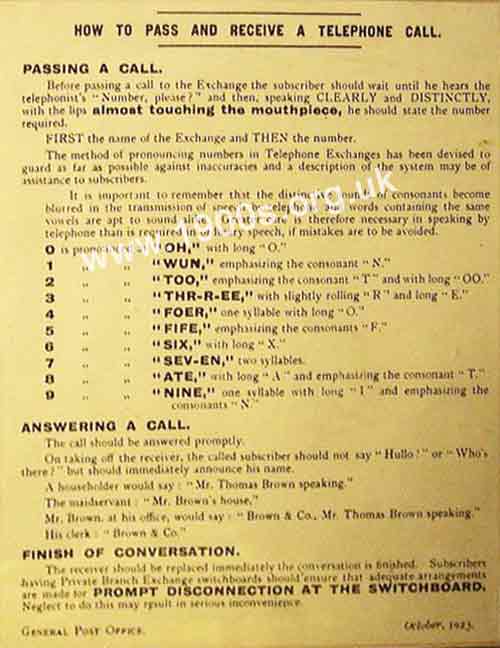
1921 poster of instructions on making and receiving phone calls: poor quality original but transcriptions are in the following boxes.
How to ask the operator to get a phone number - instructions from the Post Office
General Post Office, October 1921
[Having lifted the receiver] the subscriber should wait until he hears the telephonist saying, "Number please?" and then speak CLEARLY and DISTINCTLY with the lips almost touching the mouthpiece. Then he should state the number required. FIRST the name of the Exchange and THEN the number.
[Greater care is necessary in speaking by telephone than in ordinary speech if mistakes are to be avoided.]
0 is pronounced as "OH," with long "O."
1 is pronounced as "WUN," emphasizing the consonant "N."
2 is pronounced as "TOO," emphasizing the consonant "T" with long "OO"
3 is pronounced as "THR-R-EE," with slightly rolling "R." and long "E."
4 is pronounced as "FOER," one syllable and long "O."
5 is pronounced as "FIFE," emphasizing the consonant "F."
6 is pronounced as "SIX," with long "X."
7 is pronounced as "SEV-EN," two syllables.
8 is pronounced as "ATE," with long "A" and emphasizing the consonant "T."
9 is pronounced as "NINE," one syllable and emphasizing the
consonant "N."
Try as I may, I cannot say 4 the way the Post Office advised.
How to answer a call - instructions from the Post Office
General Post Office, October 1921
The call should be answered promptly.
On taking off the receiver, the called subscriber should not say "Hullo*" or "who's there?" but should immediately announce his name.
A householder would say: "Mr Thomas Brown speaking."
The maidservant: "Mr Brown's house."
Mr Brown at his office would say: "Brown & Co. Mr Thomas Brown speaking."
His clerk: "Brown & Co."
How to end a call - instructions from the Post Office
General Post Office, October 1921
The receiver should be replaced immediately the conversation is finished.
Subscribers having Private Branch Exchange lines [shared lines] should ensure
that adequate arrangements are made for PROMPT DISCONNECTION AT THE SWITCHBOARD.
Neglect to do this may result in serious inconvenience.
It is interesting to see how much norms have changed over the years.
Disadvantages of candlestick phones
As people today are brought up on mobile phones, it is worth pointing out that candlestick phones were not portable. They had to be wired in place.
The following disadvantages owe much to Neil Cryer and Yin Zi who both used candlestick phones as a norm when they were younger. Yin Zi still has his.
1. Candlestick phones were awkward to use. Two hands were needed: one to hold the earpiece to the ear and the other to steady the main candlestick part to keep the mouthpiece to the mouth. This meant that one part of the phone had to be put down in order to write down messages.
2. Candlestick phones were heavy. Yin Zi points out that he finds it impossible to hold the main unit of his phone for more than a couple of minutes. The base weighs 2.3kg and the earpiece 400g. He assumes that the ones they use in dramas like Downton Abbey and Sherlock Holmes must be made of plastic.
One way round the problem was to mount the phone on the wall, but it was not straightforward to position so that the speaker height was right for everyone.
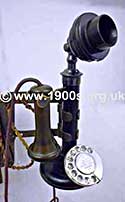
A wall-mounted candlestick phone
The newer phones of the 1940s were far more convenient in that both the mouthpiece and the earpiece were in the same unit and held in one hand, so freeing the other for dialling and taking down messages.
3. All candlestick phones needed external bell sets. These were large and bulky at the time.
4. The microphones and earpieces had poor sound quality.
5. Finally telephoning through the operator could be slow and often laborious as he or she could be working away from the smaller switchboards, housed, for example, in the backs of shops.
| sources | webmaster | contact |
Text and images are copyright
If you can add anything to this page or provide a photo, please contact me.



